There are few things in this wretched world more glorious than a perfectly smoked brisket. That’s doubly true when travelling to Texas for the real thing — or, hell, even going to a restaurant — is either impossible or could possibly kill you. Thanks to the proliferation of home-smoking tech, however, we meat lovers have more ways than ever before to recreate this juicy goodness in our own backyards.
Seeing as we’re definitely not making the trek to Texas Hill Country anytime soon, we decided to pit two leaders in the grilling world against each other in a virtual smoke-off. In one corner, the Traeger Timberline 850, and in the other, Weber’s Smokefire EX4. These pellet grills promise to make smoking anything easier than ever. But which one is truly the best? To find out, we each smoked a full packer brisket low and slow, trying our best to replicate the bark-covered black gold of the world’s best pitmasters. Below we’ll run down our experience and show you the end results. Who wins is up to you.
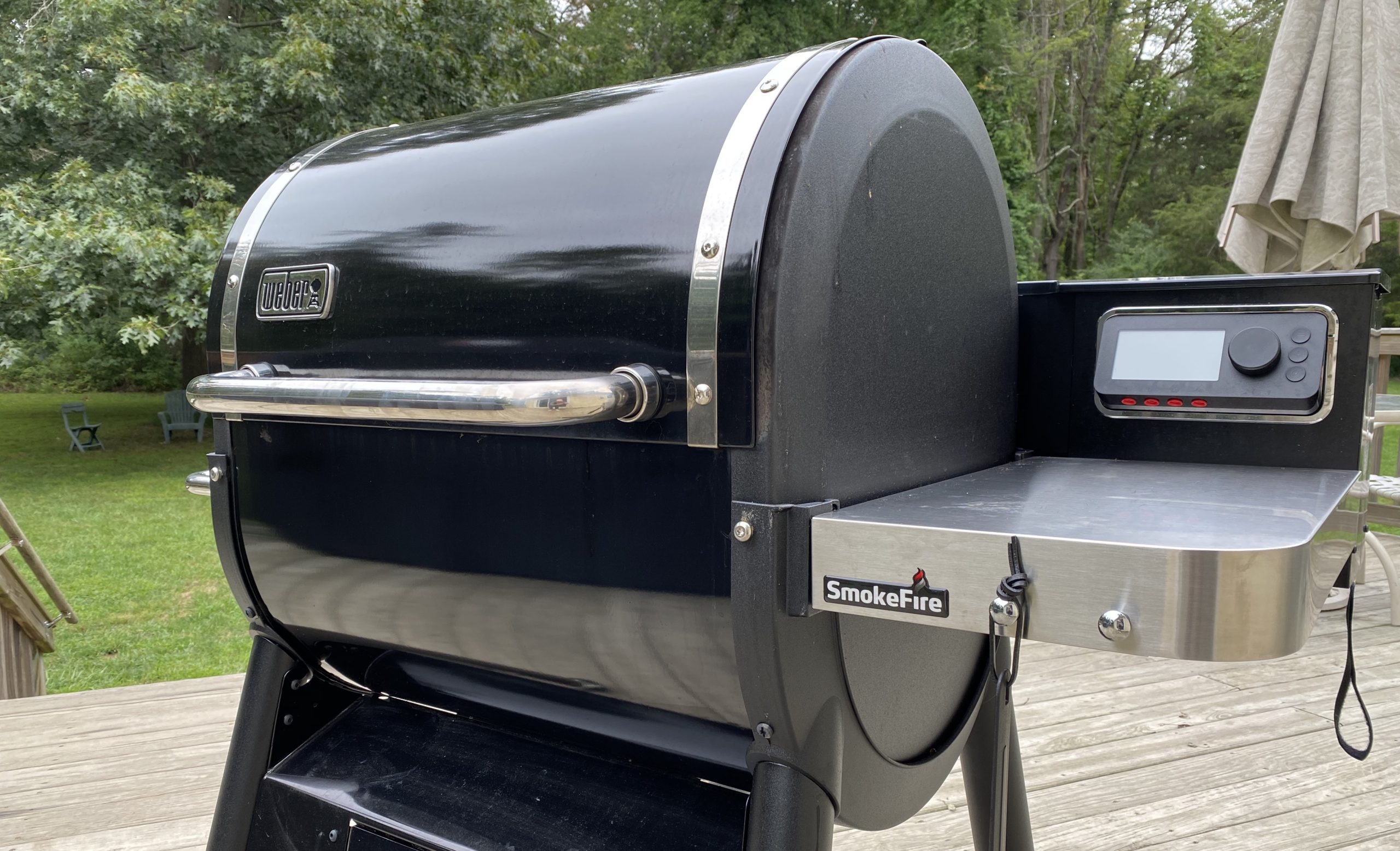
Grill: Weber Smokefire EX4 ($US1,000 ($1,377))
Meat: 6 kg packer brisket (pre-trimming)
Pitmaster: Andrew Couts, deputy editor
Confession: This was my first time ever smoking a whole brisket. I’d smoked a bunch of other things when I tested out the Smokefire earlier this year, from fish to whole chickens, to pork butts, to bacon. And I’ve smoked plenty on my trusty ol’ Weber kettle grill over the years. But the brisket is something else entirely. It’s almost mythical in my mind, and both the cost (around $US80 ($110) for the brisket I purchased) and the time it takes to smoke it properly intimidated the hell out of me.
But hey, how hard could it really be?
Before I could get to smoking, I had to trim the brisket of its copious fat. OK, “had” may be too strong a word — there’s a lot of debate in the brisket world about whether to trim at all. But I decided the approximately three inches of fat on this puppy was probably a bit too much to stomach, so I busted out the sharpest knife in my kitchen and got to work, trimming the fat down to around a quarter of an inch (or as close to that as I could get).
Trimming alone took me about 40 minutes, which wasn’t as bad as I expected but probably twice the time it takes a more experienced cook. Next, I added the seasoning: kosher salt and fresh ground pepper only, as traditional Texas Hill Country style dictates. To cover the whole thing, I jused about a quarter cup of each. Once that was done, I filled up the Smokefire with mesquite pellets and set the temperature to 225 degrees Fahrenheit.
When I tested the Smokefire over the course a month this summer, one issue that cropped up occasionally was an extreme jump or drop in temperature. This had me particularly concerned for this cook, as maintaining a consistent 225 degrees is key to ensuring the brisket’s fat deposits can properly breakdown, which is what makes a low-and-slow smoked brisket so uniquely delicious. (Indeed, cooking a brisket too fast will ensure it’s tough as a boot.) The Smokefire’s onboard thermometer isn’t particularly accurate, I’ve come to realise, so I also used my Thermoworks Smoke thermometer to keep tabs on the temperature. And I’m damn glad I did.
My brisket went on the smoker at exactly 10:45 pm on a Saturday night, with a maximum expected smoke time of around 15 hours, plus a couple hours to rest after I pulled it. I had the Smokefire’s on-board probe monitoring the brisket’s internal temperature, which I could monitor via the Weber Connect app. I also carried around the Thermowork’s thermometer remote, allowing me to monitor the internal temperature of the grill from the comfort of my favourite chair. For the first few hours, everything stayed nice and steady and I began to relax a little. Around 1am, I went to bed, phone volume turned up on high and the Thermowork’s monitor tucked under my pillow.
I awoke several hours later in a panic. With a brisket, you don’t let it just go until the very end. Instead, when the internal temperature hits about 165 degrees, you want to pull it off, wrap it, and put it back on the smoker. All of this is done to speed up the “stall,” a point in the low-and-slow smoking process where it takes dang near forever for the meat to increase in temperature. When I regained consciousness around 7:30am, having heard exactly zero alarms from all my apparently useless gadgetry, the internal temperature read 185 degrees. I was sure I’d ruined the whole thing.
Turns out, not ruined! In fact, when I bolted out onto my deck in my underwear and lifted the Smokefire’s lid, the brisket looked… fucking amazing. Just like it was supposed to. I’m too much of an amateur to know, but it seems as though I’d just slept through most of the stall. I pulled it off and wrapped it (I picked butcher’s paper, which helps release moisture for better “bark” — the crusty outside layer — development, instead of aluminium foil, which some cooks swear by) and plopped it back on, hoping for the best. Then the Smokefire went bonkers.
The problem started when I initiated the Smokefire’s “Smoke Boost” mode, which does exactly what it sounds like. Unfortunately, it also caused the smoker to drop its temperature down to around 150 degrees. When I turned Smoke Boost off and turned the temperature back up to 225, it shot up to a blazing 300 degrees. This back and forth went on for about two hours as I tried to get the temperature to stabilise, which it would do for about 20 minutes and then either drop or jump. A more experienced cook would know how much to worry about all this; I, meanwhile, freaked out the whole time.
The journey from 185 degrees to my target temperature of 202 degrees took another nearly six hours. At 1:30pm on Sunday, Weber Connect told me the temperature had hit 200 degrees. I lost my patience and pulled it, fearing the worst.
When I unwrapped the butcher’s paper, I encountered… the most delicious-looking thing I’ve ever seen. The bark was spectacular. I gave the brisket a little shake, and it jiggled like jello — just like the pitmaster blogs I’d read told me it should. It smelled truly amazing. I quickly wrapped it back up in its greasy paper blanket and popped it in a dry cooler, where it would get some much needed rest. The probe I left in to keep the precious juices from spilling out and so I could monitor its temperature and not rip into it too soon. Around 5pm, it finally hit about 140 degrees. I pulled it out of the cooler — which I’d booby trapped with a pan of water and surrounded with chairs in the hopes that my dogs or a wandering racoon wouldn’t steal it — and unwrapped it for a final time on my kitchen counter. I grabbed my slicing knife and began to cut — the moment of truth.
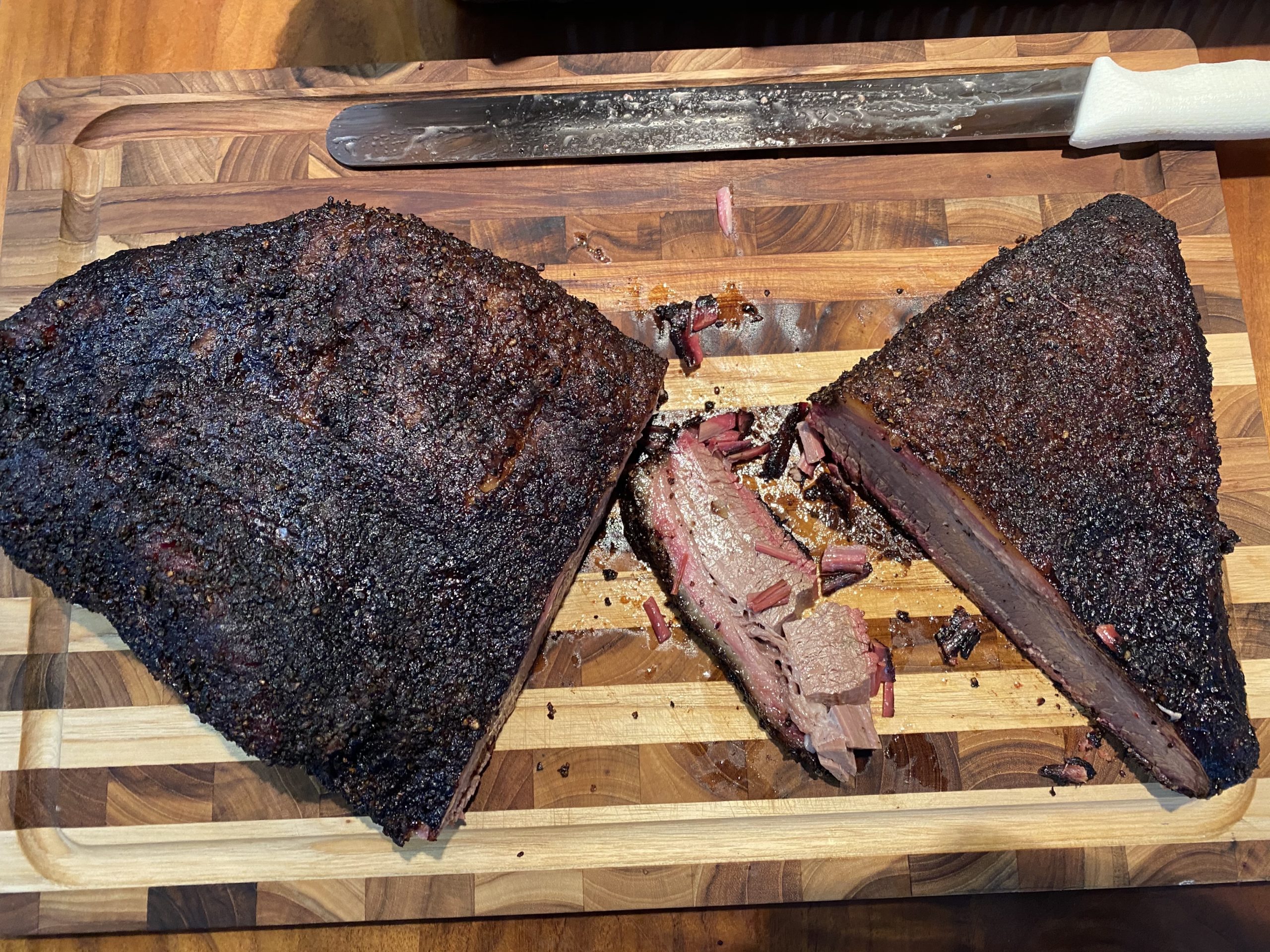
Here is a paraphrase of my literal talking-to-myself monologue in my kitchen: Holy shit. Like… what. Wow. Oh my god. Oh my god oh my god, wow. Fucking hell. It’s perfect. I think it might be perfect. I don’t deserve this. How? This is amazing.
Here is the text I sent my friend Robert, who was anxiously awaiting the results:
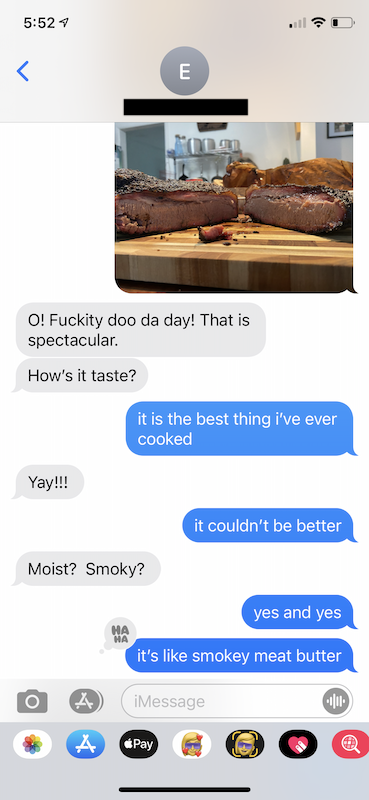
What followed next was a frankly disgusting, frantic cramming of meat into my mouth as I savoured the taste of victory. I ate so much meat in those few moments that I made myself nauseated from the oozing fat, and rendered myself unable to eat anything for a good four hours. Worth it.
I’m not sure how I possibly made a brisket this good on my first try — especially not on this pesky Smokefire with all its temperature quirks. Let’s call it beginner’s luck. If I can make it turn out even close to this good the next go around, I might consider taking some credit.
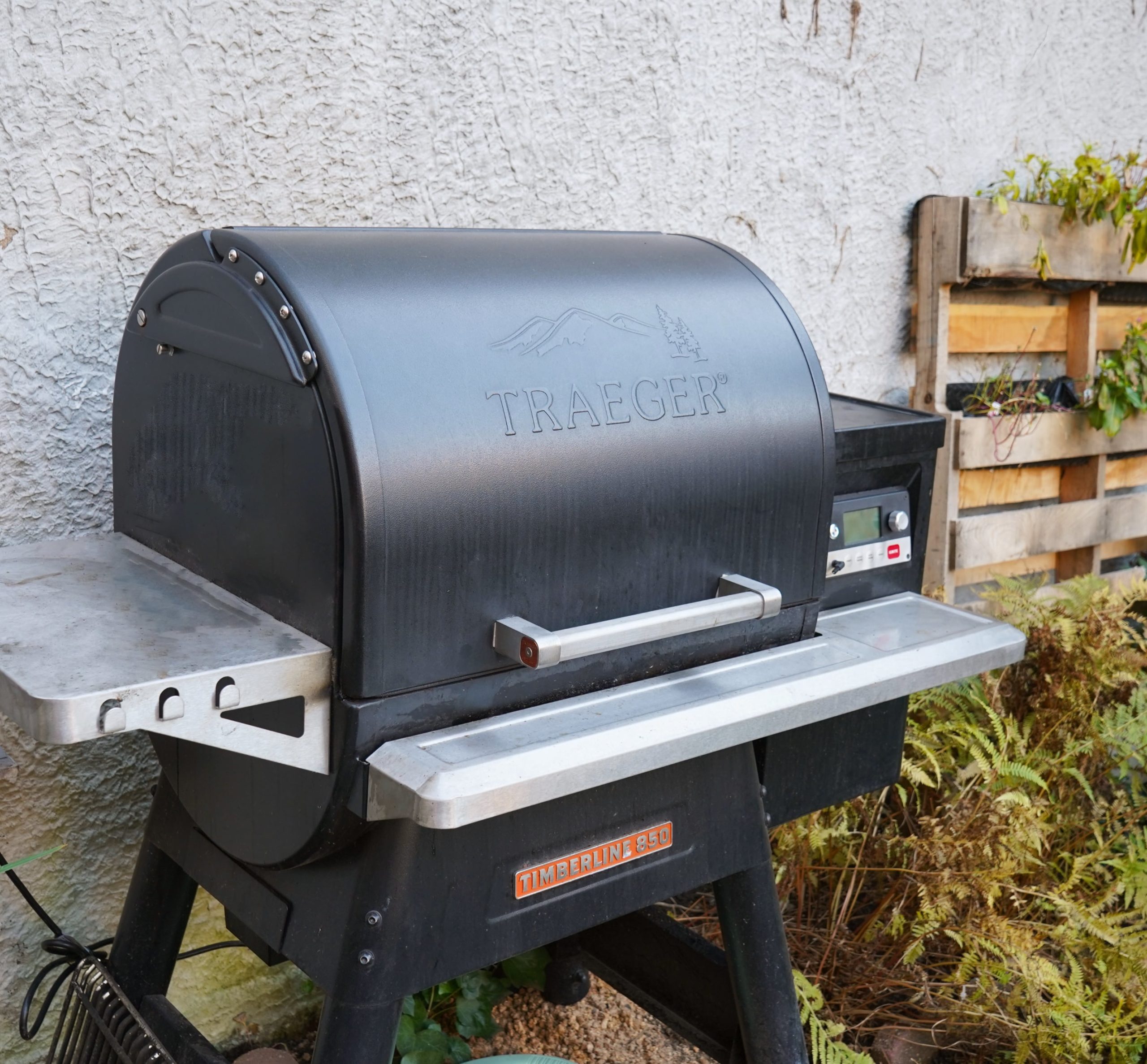
Grill: Traeger Timberline 850 ($3,799)
Meat: 5 kg brisket
Pitmaster: John Biggs, EiC
I’ve worked with pellet grills for a number of years now and that experience — plus the quality of the Timberline 850 — made my brisket superior to Andrew’s. While he won’t admit it, in terms of sheer beef performance, I beat Andrew handily. But since we’re talking about the equipment and not the superiority of the pitmaster, let’s explore what I learned.
The Timberline 850 is a hulk of a grill. Its maximum temperature of 500 degrees Fahrenheit makes it as good at making burgers and brats as it is at smoking a whole brisket. While I originally assumed I’d want to own both a gas grill and a pellet grill, the power and speed of the Timberline made the gas grill obsolete. The grill can reach 420 degrees or so in a matter of minutes, and it can hold a temperature and smoke your meat for hours. In my case, I ran a standard recipe that required smoking for six hours at 225 degrees and then a quick wrap in foil or paper for another three hours until the internal temperature hit 204 degrees. Because we wanted to eat dinner at a decent time I pulled the brisket at about 196 degrees.
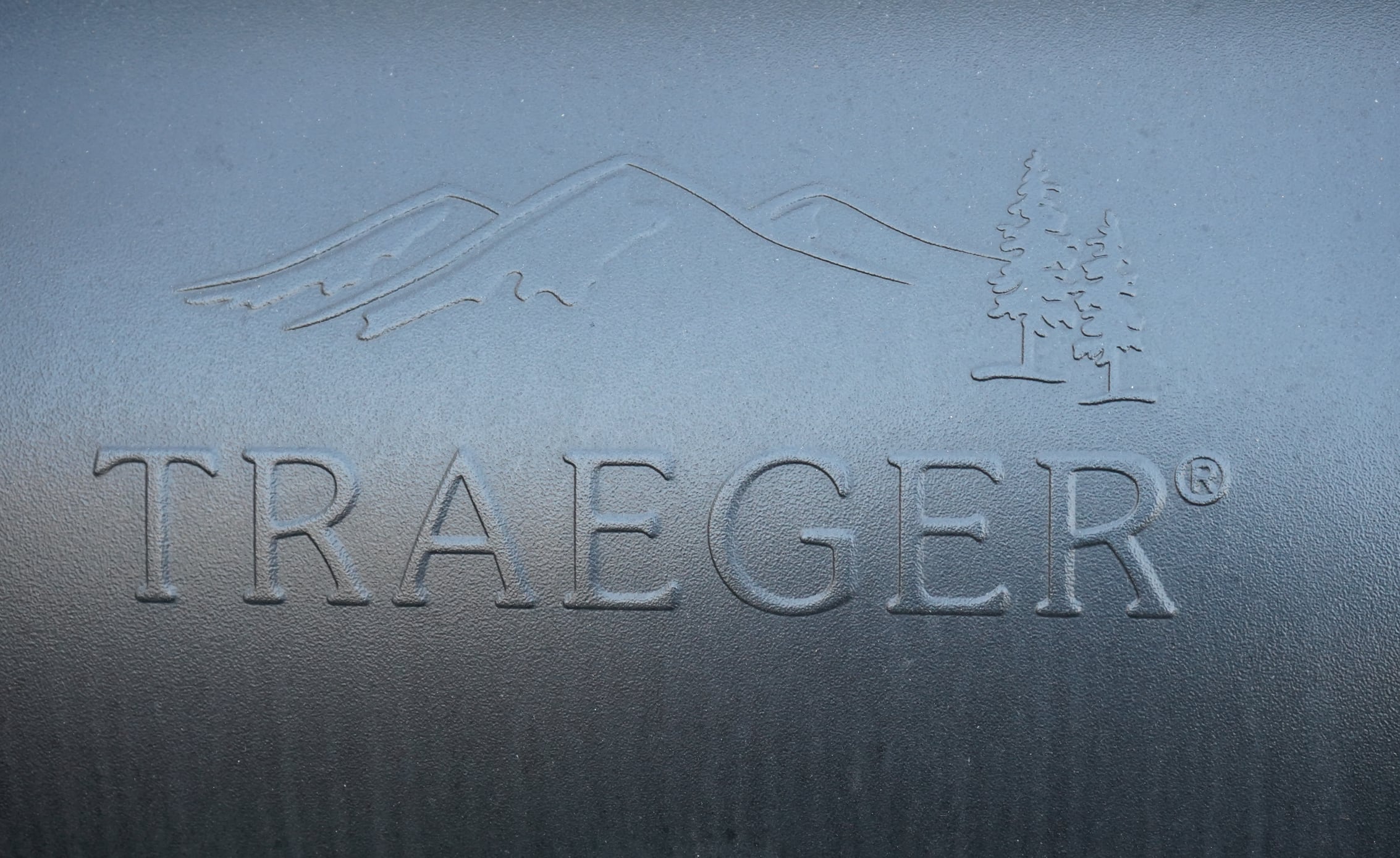
Brisket is an interesting cut. When cooked properly it turns into something akin to light pastrami and has a great red smoke ring around the outer edges and sharp, dark bark. The Traeger in particular is good at all of that and won’t leave the meat hard and dry. Unfortunately, the cut needs time, and pulling it from the grill early wasn’t the ideal decision — although it was the right one.
The Traeger includes a single thermometer probe that can be used to program the cooking process. You can send it recipes from the Traeger app and simply press a button, checking on things occasionally from the comfort of your couch. Full disclosure: My grill, probably because it didn’t support 5 GHz Wi-Fi, wasn’t connecting to my Wi-Fi properly, so I wasn’t able to manage things from an app. That said, the built-in thermometer and timers are usually enough if you’re not cooking something complex.
Because this wasn’t my first brisket on the Traeger, I was less concerned about timing and temperature than Andrew. I knew this grill would spit out some nice beef no matter what I did, provided I kept an eye on the internal temperature. That, interestingly, is one of the benefits of using a thermometer based grill. Understanding the internal temperatures of various meats and vegetables is key to cooking them properly and having that data at your fingertips is vital.
I’ve been consistently amazed by the meat that comes out of the Traeger. I’ve used a number of smokers in my day, including a Brinkmann Charcoal Smoker that I used for a number of years. Nothing has been as easy or as fun as the Traeger. Pellet anxiety — the concern that you’ll run out of fuel — aside, the pellet grill is probably one of the best inventions of the last century.
Ultimately, we loved this brisket. It was a great cut that was cooked to perfection. While Andrew got a better crust, I think our internals were far more interesting than his and, despite the high price, I’d highly recommend the Traeger to anyone with outdoor space. It’s a beast of a grill and well worth the investment.
